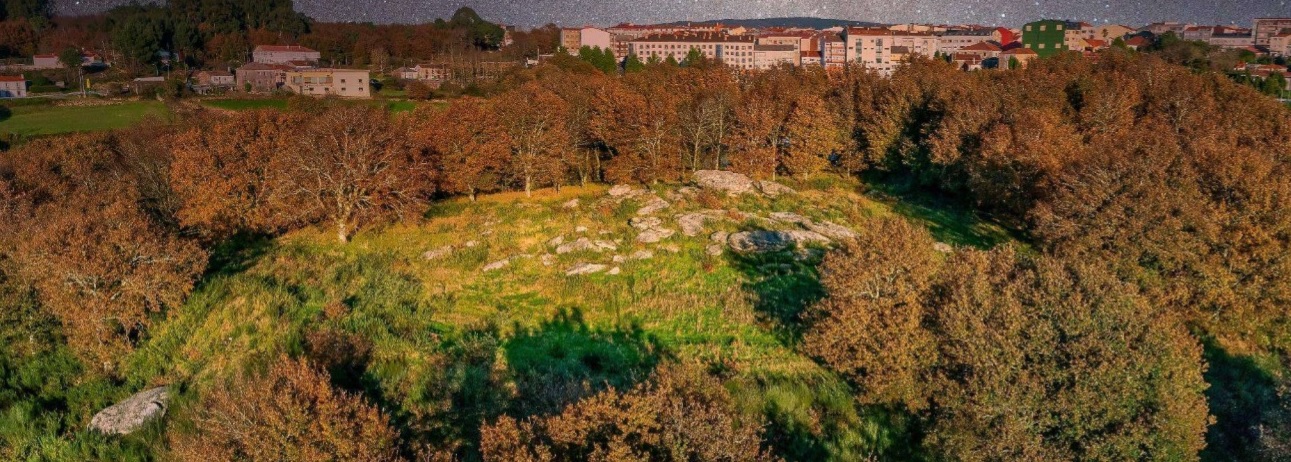The Provincial Council of Pontevedra brings the citizens closer to the rich archaeological heritage of the province of Pontevedra through the exhibition “Pegadas na paisaxe”
The Provincial Council of Pontevedra intends to get citizens to know the important archaeological heritage of the province of Pontevedra. After the success of the exhibition “Galaicos” (‘Gallaeci’) in the Museum of Pontevedra and also in Madrid and Valencia, now this institution displays the exhibition “Pegadas na paisaxe. O patrimonio de Deza” (‘Traces in the landscape. The heritage of Deza’) in the manor house Pazo de Liñares. This exhibit has 36 archaeological and ethnographic objects in total, as well as replicas of unique elements to understand our history.
This exhibition intends to show the progressive but evident transformation that the landscape has undergone from the Bronze Age up to the present time. This is an educational exhibition whose photographs and illustrations have a particularly important role, as they support the idea of Pontevedra as a territory of cultural exchange from prehistory to late antiquity.
At the opening of the exhibition, the President of the Provincial Council of Pontevedra, Carmela Silva, exalted the ‘central role’ that the province of Pontevedra used to play between the Atlantic and the Mediterranean. ‘We were a territory of cultural, trade and social exchange with all the peoples that interacted in the Phoenician’s Route’, emphasised the President, who was accompanied by the mayor of the town of Lalín, Xosé Crespo, and other political leaders of the region of Deza.
“Pegadas na paisaxe” (‘Traces in the landscape’) aims at promoting visits to the castros (pre-Roman hillfort settlements) and to other sites of Deza, but also to the ethnographic centres of the north of Pontevedra. It has pieces from three lending institutions: the Museum of Pontevedra, the Ethnographic Museum Casa do Patrón (in the village of Doade) and the Ethnographic Centre of Terra de Montes (in the village of Soutelo de Montes).

Educational unit intended for schoolchildren
At the opening, President Silva also explained that the exhibition includes an educational unit intended for children from 9 to 12 years. Different games will be offered to these children, coming with their family or their school, so they can discover the contents while having fun and dive into the knowledge of the region of Deza and the whole province of Pontevedra in a pleasant way.
The President seized the opportunity to invite all citizens to pay attention to the slogan of the campaign of Turismo Rías Baixas of this year, ‘Follow your instincts’, and to discover the valleys and mountains of the inland part of the province of Pontevedra after paying a visit to this exhibition in the manor house Pazo de Liñares. Visitors have until 24 May to enjoy this full experience where they can discover representative objects of our identity and tradition, as well as impressive landscapes that make us be defined as a paradise.
This showing, organised by Turismo Rías Baixas in collaboration with the Museum of Pontevedra, is structured around five axes, with the following titles: ‘The heritage of Pontevedra’, ‘Deza: land of castros’, ‘Devices: traces over time’, ‘Traces in the landscape of Pontevedra’, and ‘The calculation of time’.
The exhibition focuses on the castros of Montaz and Toiriz (in the village of Silleda), Castriño and Doade (in Lalín), and Pena Grande (in the village of Rodeiro), and also on another eleven settlements of the province: A Cabeciña, Penalba, Castrolandín, Alobre, Santa Trega, A Lanzada, O Castro Hill, Adro Vello, O Facho Hill, the salinas (salt ponds) of Vigo ou Toralla.
It is also shown coins, fragments of ceramic, a hatchet, a stone chip, a stela, a bronze bead, an African ring and the Roman fibula of Rodeiro, which were found in the different settlements of Deza and which belong to the period from the 1500 BCE to the 6th century.










